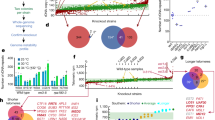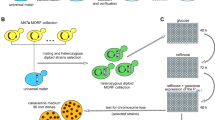Summary
Methyl-methanesulfonate (MMS) causes gene conversions in heteroallelic diploids of Saccharomyces cerevisiae. The frequency of production of prototrophic convertants is linearly proportional to the square of the time of MMS treatment, and the regression of prototrophs on dose varies depending upon the particular pair of alleles present in the diploid. The regressions show an additivity relationship, in that when a triad of heteroallelic diploids of the type m1/m2, m2/m3, and m1/m3 is considered, two of the regressions add up approximately to the third. MMS can, therefore, be used in fine structure mitotic mapping of genes. Good agreement was found both in relative order and spacing of alleles at the histidine 1 locus of yeast when the fine structure map based on the X-ray mapping method was compared with that based on MMS.
Similar content being viewed by others
References
Boyce, R. P., Farley, J. W.: Methyl-methanesulfonate-induced single strand breaks and joining of broken strands in covalent circular λ-DNA in superinfected lysogens. Biophys. J. Abstr. 8, 50 (1968).
Brookes, P., Lawley, P. D.: Reaction of some mutagenic and carcinogenic compounds with nucleic acids. J. cell. comp. Physiol. 64, Suppl. 1, 111–128 (1964).
Eisenstark, A., Eisenstark, R., Dillewijn, J. van, Rörsch, A.: Radiation-sensitive (uvr) and recombinationless (rec) mutants of Salmonella typhimurium. Bact. Proc., 36 (1968).
Freifelder, D.: Mechanism of inactivation of coli-phage T7 by X-rays. Proc. nat. Acad. Sci. (Wash.) 54, 128–134 (1965).
—: DNA strand breakage by X-irradiation. Radiat. Res. 29, 329–338 (1966).
—: Rate of production of single-strand breaks in DNA by X-irradiation in situ. J. molec. Biol. 35, 303–309 (1968).
Friedberg, E. C., Goldthwait, D. A.: Endonuclease II of E. coli. Cold Spr. Harb. Symp. quant. Biol. 33, 271–275 (1968).
Holliday, R.: A mechanism for gene conversion in fungi. Genet. Res. (Camb.) 5, 282–304 (1964).
Howard-Flanders, P., Boyce, R. P.: DNA repair and genetic recombination: studies on mutants of Escherichia coli defective in these processes. Radiat. Res., Suppl. 6, 156–184 (1966).
Johnston, J. R., Mortimer, R. K.: Use of snail digestive juice in isolation of yeast spore tetrads. J. Bact. 78, 292 (1959).
Kaplan, H. S.: DNA-strand scission and loss of viability after X-irradiation of normal and sensitized bacterial cells. Proc. nat. Acad. Sci. (Wash.) 55, 1442–1446 (1966).
Manney, T. R., Mortimer, R. K.: Allelic mapping in yeast by X-ray-induced mitotic reversion. Science 143, 581–582 (1964).
McGrath, R. A., Williams, R. W.: Reconstruction in vivo of irradiated Escherichia coli deoxyribonucleic acid; the rejoining of broken pieces. Nature (Lond.) 212, 534–535 (1966).
Reiter, H., Strauss, B.: Repair of damage induced by a monofunctional alkylating agent in a transformable, ultraviolet-sensitive strain of Bacillus subtilis. J. molec. Biol. 14, 179–194 (1965).
—, Robbins, M., Marone, R.: Nature of the repair of methyl methanesulfonate-induced damage in Bacillus subtilis. J. Bact. 93, 1056–1062 (1967).
Reno, B.: Genetic studies of radiation sensitive mutants of Saccharomyces cerevisiae. M.S. Thesis, University of California, Davis, Library (1969).
Searashi, T., Strauss, B.: Relation of the repair of damage induced by a monofunctional alkylating agent to the repair of damage induced by ultraviolet light in Bacillus subtilis. Biochem. biophys. Res. Commun. 20, 680–687 (1965).
Strauss, B., Coyle, M., Robbins, M.: Alkylation damage and its repair. Cold Spr. Harb. Symp. quant. Biol. 33, 277–287 (1968).
—, Reiter, H., Searashi, T.: Recovery from ultraviolet- and alkylating-agent-induced damage in Bacillus subtilis. Radiat. Res., Suppl. 6, 201–211 (1966).
—, Wahl, R.: The presence of breaks in the deoxyribonucleic acid of Bacillus subtilis treated in vivo with the alkylating agent, methyl-methanesulfonate. Biochim. biophys. Acta (Amst.) 80, 116–126 (1964).
Wahl, R.: Detection of single strand breaks in DNA alkylated in vitro. Fed. Proc. 24, 226 (1965).
Yost, H. T., Chaleff, R. S., Finerty, J. P.: Induction of mitotic recombination in Saccharomyces cerevisiae by ethyl methane sulfonate. Nature (Lond.) 215, 660–661 (1967).
Author information
Authors and Affiliations
Additional information
Communicated by G. Magni
Rights and permissions
About this article
Cite this article
Snow, R., Korch, C.T. Alkylation induced gene conversion in yeast: Use in fine structure mapping. Molec. Gen. Genet. 107, 201–208 (1970). https://doi.org/10.1007/BF00268694
Received:
Issue Date:
DOI: https://doi.org/10.1007/BF00268694




